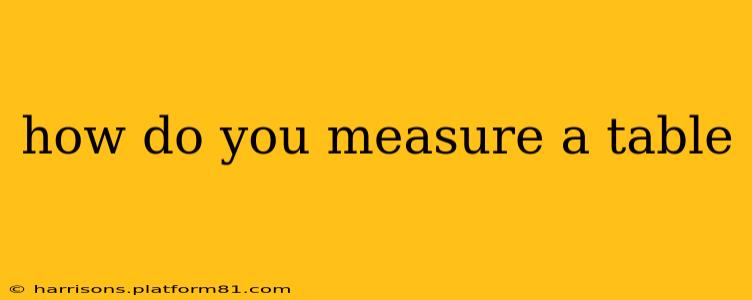How Do You Measure a Table? A Comprehensive Guide
Measuring a table might seem straightforward, but getting accurate dimensions is crucial for various reasons – from buying a table runner or tablecloth to fitting it into a specific space. This guide will walk you through how to measure a table accurately, covering different table shapes and addressing common questions.
What Tools Do You Need?
Before you begin, gather the following:
- Measuring Tape: A flexible tape measure at least 3-4 feet long is ideal. A longer one is even better for larger tables.
- Pen and Paper: To record your measurements.
- Calculator (Optional): Useful for calculating areas or perimeters.
Measuring Different Table Shapes:
The method for measuring a table depends on its shape. Here's a breakdown:
1. Rectangular or Square Tables:
This is the simplest type of table to measure. You'll need to measure the length and width.
- Length: Measure the longest side of the table from one corner to its opposite corner.
- Width: Measure the shortest side, perpendicular to the length.
- Height: Measure from the floor to the top of the table.
2. Round Tables:
Measuring a round table is also fairly straightforward:
- Diameter: Measure the distance across the widest part of the table, passing through the center. You can measure from one edge, through the center, to the opposite edge.
- Height: Measure from the floor to the top of the table.
3. Oval Tables:
Oval tables require measuring two dimensions:
- Length: Measure the longest distance from one end of the oval to the other.
- Width: Measure the widest distance across the oval.
- Height: Measure from the floor to the top of the table.
4. Irregularly Shaped Tables:
Tables with unique shapes can be more challenging to measure. You might need to break down the measurement into smaller sections. For example, you might measure the length of each side individually and then the width at several points along its length if necessary.
Important Considerations:
- Accuracy: Take multiple measurements to ensure accuracy, particularly for irregularly shaped tables. Compare your measurements to ensure consistency.
- Overhang: If you're buying a tablecloth or runner, consider the desired overhang. Add extra inches to your measurements to allow for drape.
- Table Legs: Consider the width of the table legs if you are planning on placing something along the sides.
Frequently Asked Questions (FAQs)
Here are some common questions people ask about measuring tables:
How do I measure a table for a tablecloth?
To measure a table for a tablecloth, measure the length and width of the tabletop. Add extra inches to each measurement to allow for desired overhang (typically 6-12 inches on each side). This creates a nice drape and ensures the tablecloth covers the table completely.
How do I measure a drop leaf table?
Measuring a drop-leaf table requires measuring in two stages:
- Leaves Down: Measure the length and width of the table with the leaves folded down.
- Leaves Up: Measure the length and width of the table with the leaves extended. Record both sets of measurements.
What is the standard height of a dining table?
The standard height of a dining table is typically 28-30 inches. However, this can vary depending on the style and intended use of the table.
How do I measure a table for a table runner?
To measure for a table runner, measure the length of the table where you want the runner to be placed. Then, decide the desired width of the runner. Remember, table runners are typically narrower than the width of the table.
Measuring a table accurately is crucial for many tasks. By following these steps and considerations, you'll be able to get precise measurements and avoid any frustrating miscalculations. Remember, always double-check your measurements to ensure accuracy!
